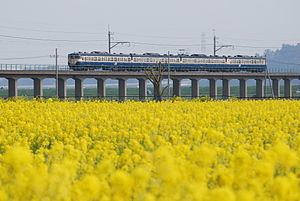Type Heavy rail Opened 1970 Line length 17.4 km (10.8 mi) | Stations 6 Operator(s) JR East, JR Freight | |
 | ||
Terminis | ||
Oarai kashima line at mito station
The Kashima Line (鹿島線, Kashima-sen) is a railway line operated by East Japan Railway Company (JR East). It links Katori Station with Kashima Soccer Stadium Station, by crossing and then following the Tone River, the border between Chiba Prefecture and Ibaraki Prefecture.
Contents
Operation
Katori Station is in Narita Line, and all trains of Kashima Line run through from/to the neighbor station, Sawara Station, or beyond it, but all trains terminate at Kashima-Jingū Station. Only Kashima Rinkai Railway Ōarai Kashima Line trains run from here to Kashima Soccer Stadium and Mito Station. Kashima Soccer Stadium Station is only operated temporarily when football matches are held at Kashima Soccer Stadium, the home stadium of Kashima Antlers in J.League (Japan Professional Football League).
From Sawara to Kashima Jingu, JR East local electric trains run approximately once per 1–2 hours. Some trains run beyond Sawara, to Narita Station or Chiba Station. The Limited Express Ayame service runs between Tokyo Station and Kashima Jingu once in a day, from Kashima Jingu in every morning, from Tokyo in every night. It operates as an all-stations "Local" train over the Kashima Line. From Kashima-Jingū and Mito, Oarai Kashima Line local or rapid diesel trains run approximately once an hour. Normally, no passenger train stops at Kashima Soccer Stadium, except when football matches are played in the stadium.
JR Freight operates trains on the line, from Tokyo area to Kashima Rinko Line. The trains change its directions at Kashima Soccer Stadium.
History
This line was planned as the main mass transportation method within the Kashima Industrial Zone along the southern coast of Ibaraki Prefecture, to connect with the Tokyo Metropolis.
